Breathers, Transformation Mechanisms and Their Molecular State of a (3+1)-Dimensional Generalized Yu–Toda–Sasa–Fukuyama Equation
Abstract
1. Introduction
2. Bilinear Form and the Soliton Solution
3. One-Breather Solution and Transformation Mechanism
- (1)
- (2)
- It can be noticed that the velocity of the one-lump wave (13) is available. On the plane, the velocity of lump wave along the x axis is , and the speed along the y axis is .
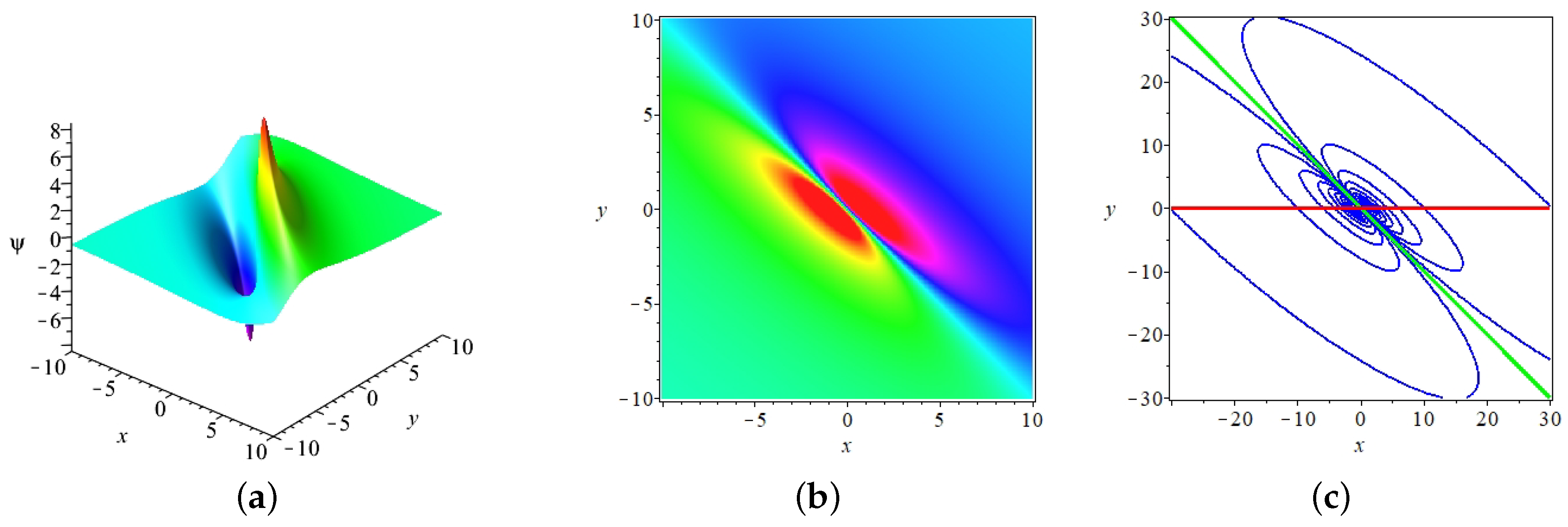
- (1)
- It is obvious from expression (9) that the one-breather solution contains a trigonometric function and a hyperbolic function , in which the localized properties of the one-breather are controlled by the hyperbolic function, and the periodic properties are decided by the trigonometric function, so the one-breather can be considered to be the combination of the soliton wave and periodic wave.
- (2)
- Two characteristic lines of the one-breather have the form of and
- (3)
- It can be noticed that the velocities of the soliton along the x axis and y axis can be written as and , respectively; the velocities of periodic wave along x axis and y axis are and , respectively; the above results are discussed on the plane , and similar conclusions can be obtained on the plane and plane.
- (i)
- If the relationship is satisfied, i.e., the two characteristic lines and will not be parallel in the plane , as shown in Figure 1.
- (ii)
- If the relationship is satisfied, i.e., the two characteristic lines and will be parallel, as shown in Figure 3 and Figure 4. Under special conditions, the one-breather can be converted into a series of nonlinear waves which include quasi-kink soliton, M-shaped kink soliton, oscillation M-shaped kink soliton, multi-peak kink soliton and quasi-periodic wave. In Figure 3a–c, the one-breather will be a transformed quasi-kink soliton , which has one characteristic line and presents the shape of a ladder. In Figure 3d–f, the M-shaped kink soliton has two peaks and one valley, and appears in the shape of M climbing upward. With the increase of value of , the one-breather will become an oscillation M-shaped kink soliton , and the number of characteristic lines also increases. If the value of keeps growing, the periodicity will become obvious, then the one-breather will become an asymmetric multi-peak kink soliton , as shown in Figure 4a–f. When the value becomes very large, the one-breather will be transformed into a quasi-periodic wave , as shown in Figure 4g–i. Gradually, with the values of increasing, their periodicity becomes more and more obvious and their locality almost disappears.
4. Two-Breather Solution, Transformation Mechanism and Molecular State
4.1. Two-Breather Solution of Equation (3)
- (1)
- If the two-breather satisfies i.e., the two-breather is parallel, whereas they will only collide at a certain time due to different speeds, which is called the short-lived collision, as shown in Figure 6.
- (2)
- If the two-breather satisfies i.e., the two-breather is not parallel; in other words, they will always be in a state of intersection, which is called the long-lived collision, as shown in Figure 7.

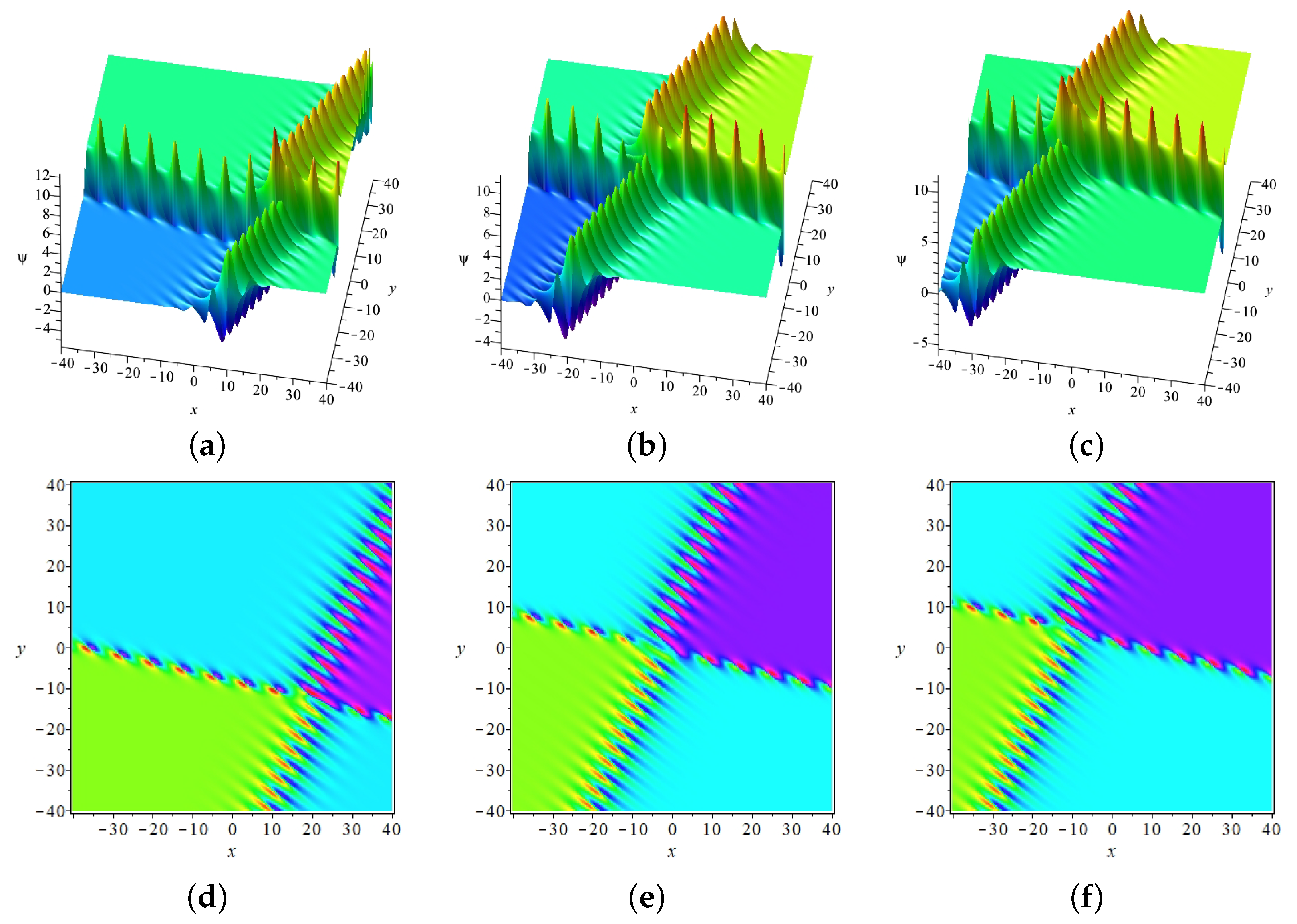
4.2. Transformation Mechanism of Two-Breather for Equation (3)
4.3. Molecular State of Transformed Two-Breather
5. Conclusions
Author Contributions
Funding
Conflicts of Interest
References
- Mani Rajan, M.S.; Mahalingam, A. Nonautonomous solitons in modified inhomogeneous Hirota equation: Soliton control and soliton interaction. Nonlinear Dyn. 2015, 79, 2469–2484. [Google Scholar] [CrossRef]
- Ma, W.X. N-soliton solution of a combined pKP-BKP equation. J. Geom. Phys. 2021, 165, 104191. [Google Scholar] [CrossRef]
- Shen, Y.; Tian, B. Bilinear auto-Bäcklund transformations and soliton solutions of a (3+1)-dimensional generalized nonlinear evolution equation for the shallow water waves. Appl. Math. Lett. 2021, 122, 107301. [Google Scholar] [CrossRef]
- Mo, Y.F.; Ling, L.M.; Zeng, D.L. Data-driven vector soliton solutions of coupled nonlinear Schrödinger equation using a deep learning algorithm. Phys. Lett. A 2022, 421, 127739. [Google Scholar] [CrossRef]
- Wang, L.H.; Porsezian, K.; He, J.S. Breather and rogue wave solutions of a generalized nonlinear Schrödinger equation. Phys. Rev. E 2013, 87, 53202. [Google Scholar] [CrossRef]
- Feng, B.F.; Ma, R.Y.; Zhang, Y.J. General breather and rogue wave solutions to the complex short pulse equation. Phys. D 2022, 439, 133360. [Google Scholar] [CrossRef]
- Yusuf, A.; Sulaiman, T.A.; Alshomrani, A.S.; Baleanu, D. Breather and lump-periodic wave solutions to a system of nonlinear wave model arising in fluid mechanics. Nonlinear Dyn 2022, 110, 3655–3669. [Google Scholar] [CrossRef]
- Zhao, Z.L.; Chen, Y.; Han, B. Lump soliton, mixed lump stripe and periodic lump solutions of a (2+1)-dimensional asymmetrical Nizhnik-Novikov-Veselov equation. Modern Phys. Lett. B 2017, 31, 1750157. [Google Scholar] [CrossRef]
- Ma, W.X.; Zhou, Y. Lump solutions to nonlinear partial differential equations via Hirota bilinear forms. J. Differ. Equ. 2018, 264, 2633–2659. [Google Scholar] [CrossRef]
- Zhao, Z.L.; Yue, J.; He, L.C. New type of multiple lump and rogue wave solutions of the (2+1)-dimensional Bogoyavlenskii-Kadomtsev-Petviashvili equation. Appl. Math. Lett. 2022, 133, 108294. [Google Scholar] [CrossRef]
- Zhao, Z.L.; He, L.C.; Wazwaz, A.M. Dynamics of lump chains for the BKP equation describing propagation of nonlinear waves. Chin. Phys. B 2023, 32, 040501. [Google Scholar] [CrossRef]
- Zhao, Z.L.; He, L.C. Multiple lump molecules and interaction solutions of the Kadomtsev-Petviashvili I equation. Commun. Theor. Phys. 2022, 74, 105004. [Google Scholar] [CrossRef]
- Fan, E.G.; Hon, Y.C. Quasiperiodic waves and asymptotic behavior for Bogoyavlenskii’s breaking soliton equation in (2+1) dimensions. Phys. Rev. E 2008, 78, 36607. [Google Scholar] [CrossRef]
- Luo, L.; Fan, E.G. Bilinear approach to the quasi-periodic wave solutions of Modified Nizhnik-Novikov-Vesselov equation in (2+1) dimensions. Phys. Lett. A 2010, 374, 3001–3006. [Google Scholar] [CrossRef]
- Yue, J.; Zhao, Z.L. Solitons, breath-wave transitions, quasi-periodic waves and asymptotic behaviors for a (2+1)-dimensional Boussinesq-type equation. Eur. Phys. J. Plus 2022, 137, 914. [Google Scholar] [CrossRef]
- Li, J.; Sun, G.Q.; Jin, Z. Interactions of time delay and spatial diffusion induce the periodic oscillation of the vegetation system. Discrete Contin. Dyn. Syst. B 2022, 27, 2147–2172. [Google Scholar] [CrossRef]
- Zhou, T.Y.; Tian, B.; Chen, Y.Q.; Shen, Y. Painlevé analysis, auto-Bäcklund transformation and analytic solutions of a (2+1)-dimensional generalized Burgers system with the variable coefficients in a fluid. Nonlinear Dyn. 2022, 108, 2417–2428. [Google Scholar] [CrossRef]
- Dong, S.; Lan, Z.Z.; Gao, B.; Shen, Y.J. Bäcklund transformation and multi-soliton solutions for the discrete Korteweg-de Vries equation. Appl. Math. Lett. 2022, 125, 107747. [Google Scholar] [CrossRef]
- Yin, Y.H.; Lü, X.; Ma, W.X. Bäcklund transformation, exact solutions and diverse interaction phenomena to a (3+1)-dimensional nonlinear evolution equation. Nonlinear Dyn. 2022, 108, 4181–4194. [Google Scholar] [CrossRef]
- Mikhailov, A.V. The reduction problem and the inverse scattering method. Phys. D 1981, 3, 73–117. [Google Scholar] [CrossRef]
- Ning, T.K.; Chen, D.Y.; Zhang, D.J. The exact solutions for the nonisospectral AKNS hierarchy through the inverse scattering transform. Phys. A 2004, 339, 248–266. [Google Scholar] [CrossRef]
- Chen, M.S.; Fan, E.G.; He, J.S. l2-Sobolev space bijectivity of the scattering-inverse scattering transforms related to defocusing Ablowitz-Ladik systems. Phys. D 2023, 443, 133565. [Google Scholar] [CrossRef]
- Guo, B.L.; Ling, L.M.; Liu, Q.P. Nonlinear Schrödinger equation: Generalized Darboux transformation and rogue wave solutions. Phys. Rev. E 2012, 85, 26607. [Google Scholar] [CrossRef] [PubMed]
- Song, J.Y.; Xiao, Y.; Zhang, C.P. Darboux transformation, exact solutions and conservation laws for the reverse space-time Fokas-Lenells equation. Nonlinear Dyn. 2022, 107, 3805–3818. [Google Scholar] [CrossRef]
- Krichever, I.M. Methods of algebraic geometry in the theory of nonlinear equations. Russ. Math. Surv. 1977, 32, 185–213. [Google Scholar] [CrossRef]
- Cao, C.W.; Xiao, Y. Algebraic-geometric solution to (2+1)-dimensional Sawada-Kotera equation. Commun. Theor. Phys. 2008, 49, 34–36. [Google Scholar]
- Hirota, R. Exact solution of the Korteweg-de Vries equation for multiple collisions of solitons. Phys. Rev. Lett. 1971, 27, 1192–1194. [Google Scholar] [CrossRef]
- Hirota, R. The Direct Method in Soliton Theory; Cambridge University Press: Cambridge, UK, 2004. [Google Scholar]
- Bluman, G.W.; Yang, Z.Z. A symmetry-based method for constructing nonlocally related partial differential equation systems. J. Math. Phys. 2013, 54, 93504. [Google Scholar] [CrossRef]
- Liu, H.Z.; Li, J.B.; Zhang, Q.X. Lie symmetry analysis and exact explicit solutions for general Burgers’ equation. J. Comput. Appl. Math. 2009, 228, 1–9. [Google Scholar] [CrossRef]
- Zhao, Z.L.; Han, B. Lie symmetry analysis, Bäcklund transformations, and exact solutions of a (2+1)-dimensional Boiti-Leon-Pempinelli system. J. Math. Phys. 2017, 58, 101514. [Google Scholar] [CrossRef]
- Zhao, Z.L.; He, L.C. Lie symmetry, nonlocal symmetry analysis, and interaction of solutions of a (2+1)-dimensional KdV-mKdV equation. Theor. Math. Phys. 2021, 206, 142–162. [Google Scholar] [CrossRef]
- Zhang, X.; Wang, L.; Liu, C.; Li, M.; Zhao, Y.C. High-dimensional nonlinear wave transitions and their mechanisms. Chaos 2020, 30, 113107. [Google Scholar] [CrossRef]
- Zhang, X.; Wang, L.; Chen, W.Q.; Yao, X.M.; Wang, X.; Zhao, Y.C. Dynamics of transformed nonlinear waves in the (3+1)-dimensional B-type Kadomtsev-Petviashvili equation I: Transitions mechanisms. Commun. Nonlinear Sci. Numer. Simul. 2022, 105, 106070. [Google Scholar] [CrossRef]
- Yin, Z.Y.; Tian, S.F. Nonlinear wave transitions and their mechanisms of (2+1)-dimensional Sawada-Kotera equation. Phys. D 2021, 427, 133002. [Google Scholar] [CrossRef]
- Zhang, D.D.; Wang, L.; Liu, L.; Liu, T.X.; Sun, W.R. Shape-changed propagations and interactions for the (3+1)-dimensional generalized Kadomtsev-Petviashvili equation in fluids. Commun. Theor. Phys. 2021, 73, 95001. [Google Scholar] [CrossRef]
- Yao, X.M.; Wang, L.; Zhang, X.; Zhang, Y.B. Dynamics of transformed nonlinear waves in the (3+1)-dimensional B-type Kadomtsev-Petviashvili equation II: Interactions and molecular waves. Nonlinear Dyn. 2023, 111, 4613–4629. [Google Scholar] [CrossRef]
- Jia, M.; Lin, J.; Lou, S.Y. Soliton and breather molecules in few-cycle-pulse optical model. Nonlinear Dyn. 2020, 100, 3745–3757. [Google Scholar] [CrossRef]
- Yan, Z.W.; Lou, S.Y. Special types of solitons and breather molecules for a (2+1)-dimensional fifth-order KdV equation. Commun. Nonlinear Sci. Numer. Simul. 2020, 91, 105425. [Google Scholar] [CrossRef]
- Wang, M.M.; Qi, Z.Q.; Chen, J.C.; Li, B. Resonance Y-shaped soliton and interaction solutions in the (2+1)-dimensional B-type Kadomtsev-Petviashvili equation. Internat. J. Modern Phys. B 2021, 35, 2150222. [Google Scholar] [CrossRef]
- Zhang, Z.; Yang, S.X.; Li, B. Soliton molecules, asymmetric solitons and hybrid solutions for (2+1)-dimensional fifth-order KdV equation. Chinese Phys. Lett. 2019, 36, 120501. [Google Scholar] [CrossRef]
- Zhao, Z.L.; He, L.C. Nonlinear superposition between lump waves and other waves of the (2+1)-dimensional asymmetrical Nizhnik-Novikov-Veselov equation. Nonlinear Dyn. 2022, 108, 555–568. [Google Scholar] [CrossRef]
- Yue, J.; Zhao, Z.L. Interaction solutions and molecule state between resonance Y-type solitons and lump waves, and transformed 2-breather molecular waves of a (2+1)-dimensional asymmetrical Nizhnik-Novikov-Veselov equation. Nonlinear Dyn. 2023, 111, 7565–7589. [Google Scholar] [CrossRef]
- Yu, S.J.; Toda, K.; Sasa, N.; Fukuyama, T. N soliton solutions to the Bogoyavlenskii-Schiff equation and a quest for the soliton solution in (3+1) dimensions. J. Phys. A: Math. Gen. 1998, 31, 3337–3347. [Google Scholar] [CrossRef]
- Yin, H.M.; Tian, B.; Chai, J.; Wu, X.Y.; Sun, W.R. Solitons and bilinear Bäcklund transformations for a (3+1)-dimensional Yu-Toda-Sasa-Fukuyama equation in a liquid or lattice. Appl. Math. Lett. 2016, 58, 178–183. [Google Scholar] [CrossRef]
- Guo, H.D.; Xia, T.C.; Hu, B.B. Dynamics of abundant solutions to the (3+1)-dimensional generalized Yu-Toda-Sasa-Fukuyama equation. Appl. Math. Lett. 2020, 105, 106301. [Google Scholar] [CrossRef]
- Shen, Y.; Tian, B.; Zhao, X.; Shan, W.R.; Jiang, Y. Bilinear form, bilinear auto-Bäcklund transformation, breather and lump solutions for a (3+1)-dimensional generalised Yu-Toda-Sasa-Fukuyama equation in a two-layer liquid or a lattice. Pramana-J. Phys. 2021, 95, 137. [Google Scholar] [CrossRef]
- Adeyemo, O.D.; Khalique, C.M.; Gasimov, Y.S. Variational and non-variational approaches with Lie algebra of a generalized (3+1)-dimensional nonlinear potential Yu-Toda-Sasa-Fukuyama equation in engineering and physics. Alex. Eng. J. 2023, 63, 17–43. [Google Scholar] [CrossRef]
- Ablowitz, M.J.; Satsuma, J. Solitons and rational solutions of nonlinear evolution equations. J. Math. Phys. 1978, 19, 2180–2186. [Google Scholar] [CrossRef]
- Satsuma, J.; Ablowitz, M.J. Two-dimensional lumps in nonlinear dispersive systems. J. Math. Phys. 1979, 20, 1496–1503. [Google Scholar] [CrossRef]
- Zhang, Z.; Guo, Q.; Li, B.; Chen, J.C. A new class of nonlinear superposition between lump waves and other waves for Kadomtsev-Petviashvili I equation. Commun. Nonlinear Sci. Numer. Simul. 2021, 101, 105866. [Google Scholar] [CrossRef]

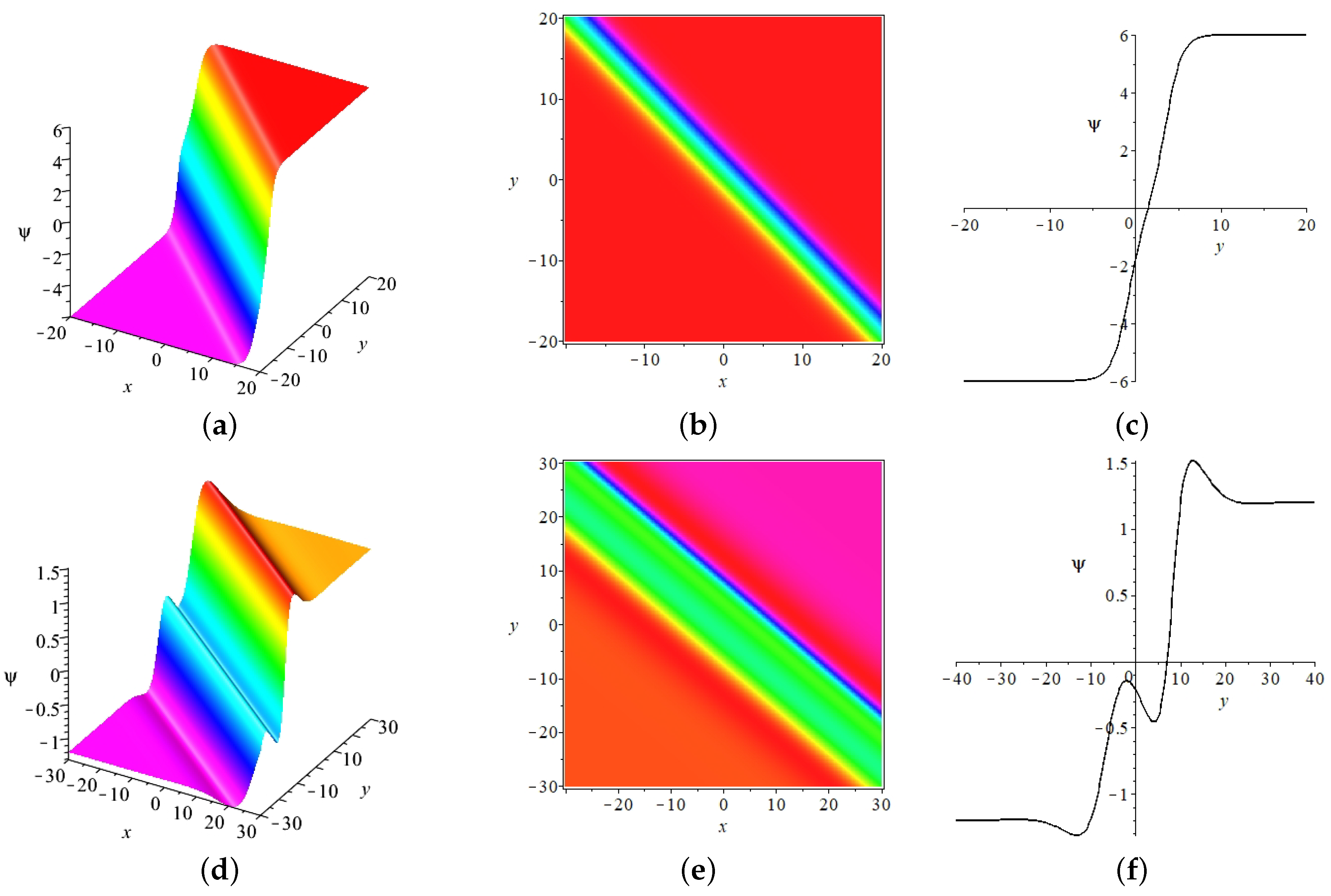
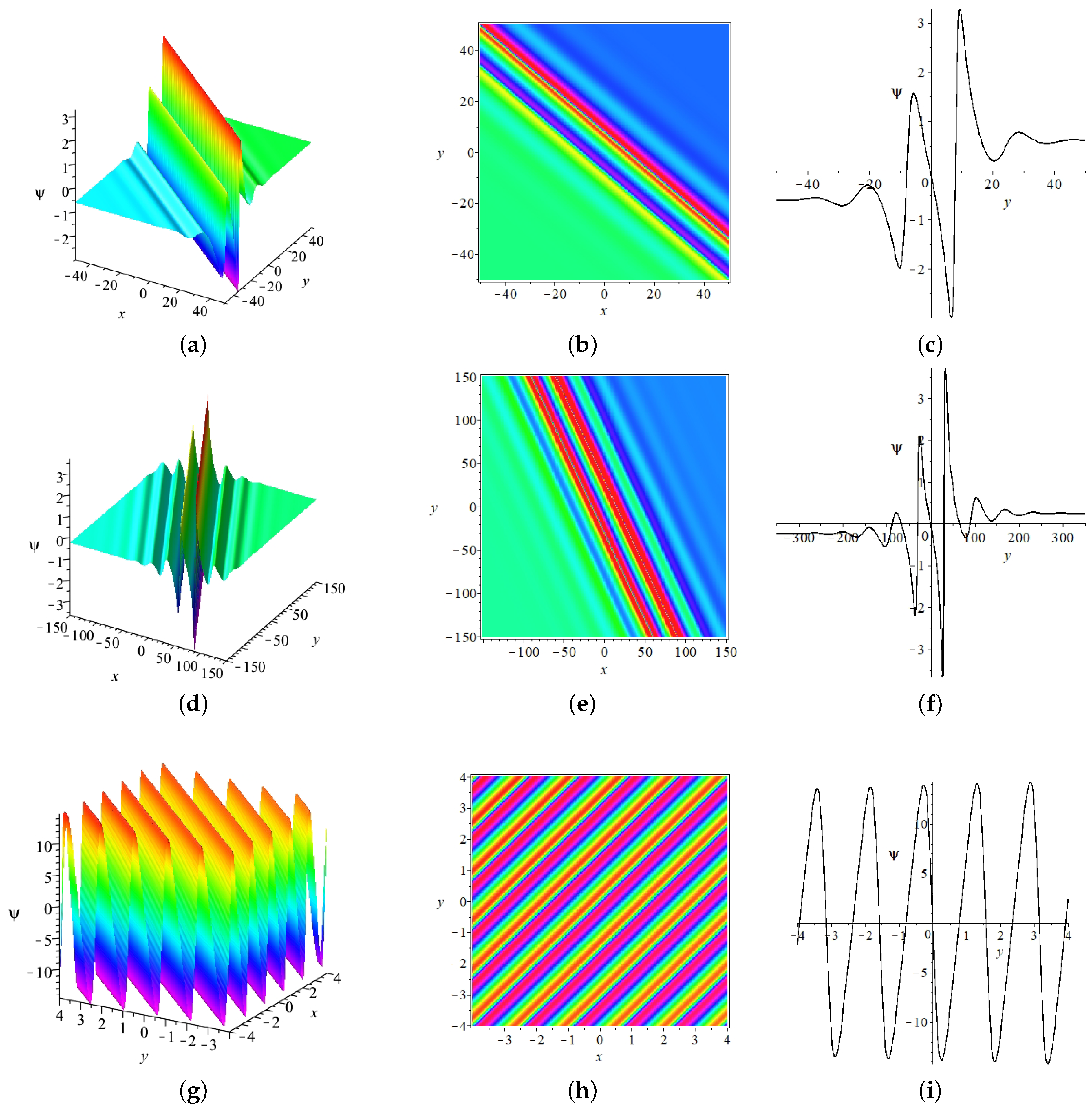
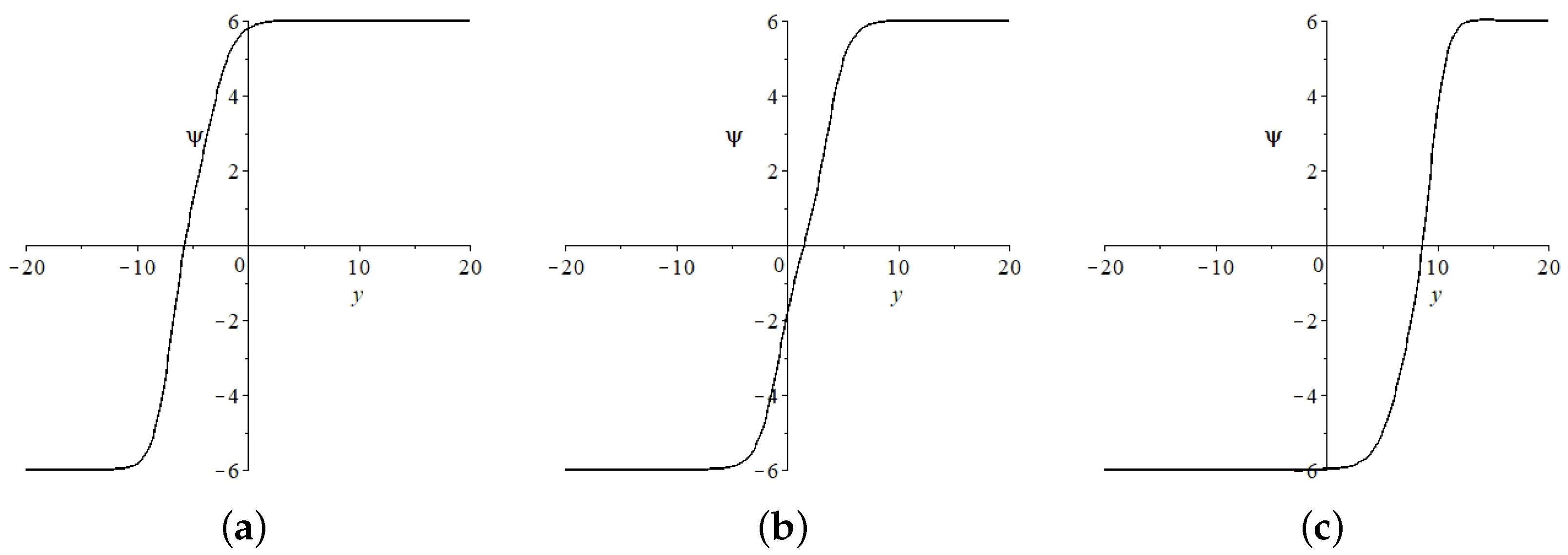

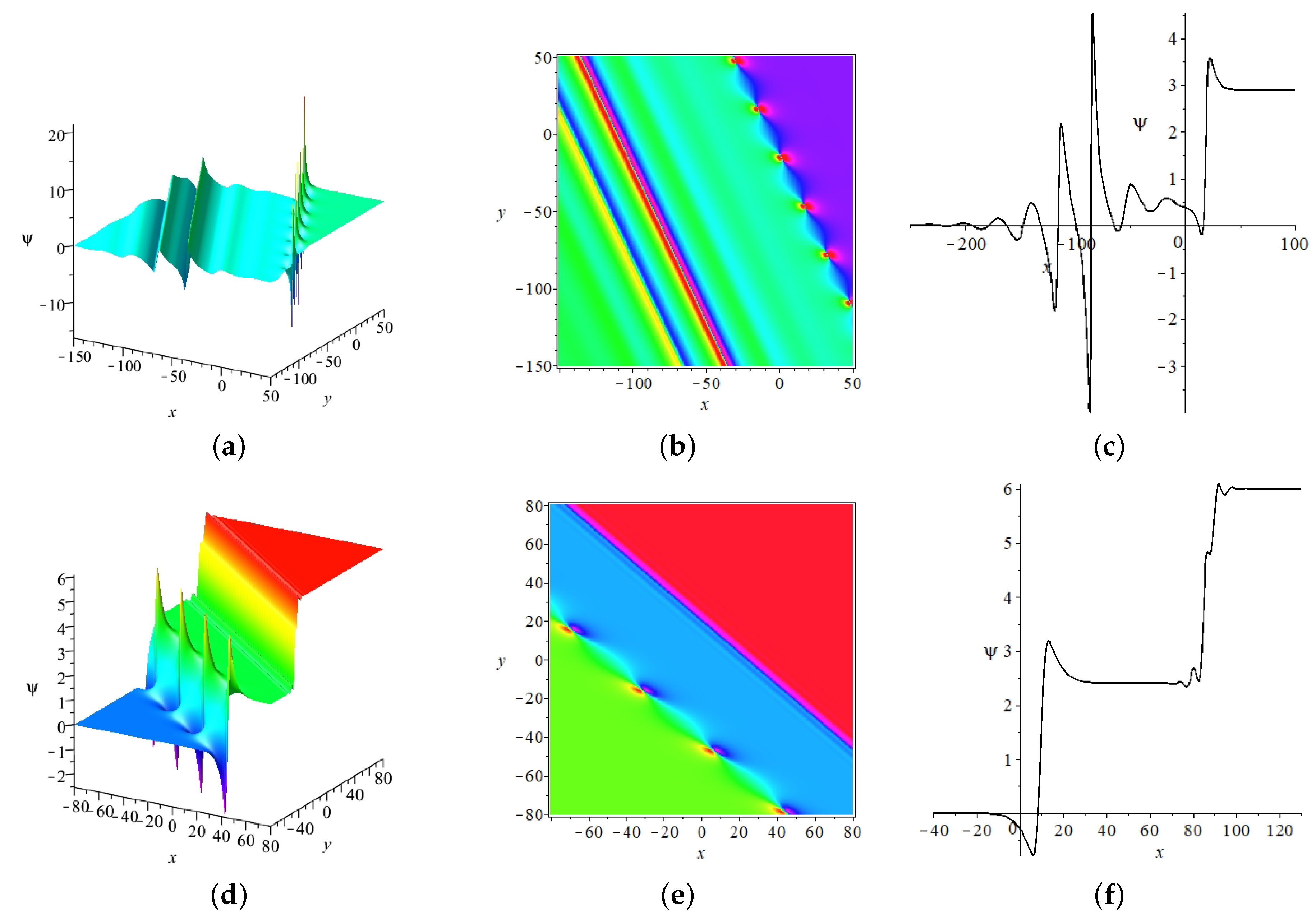
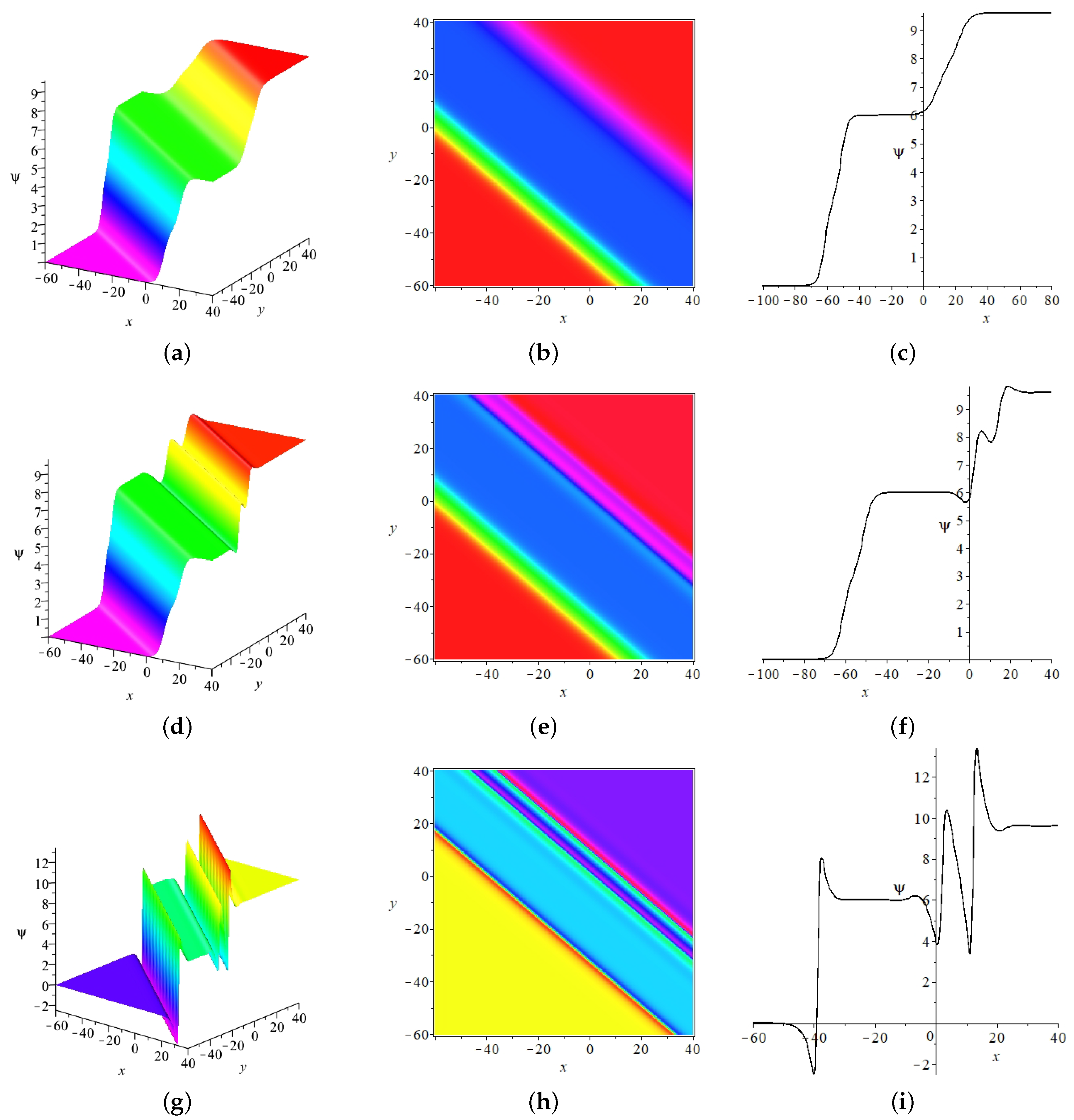
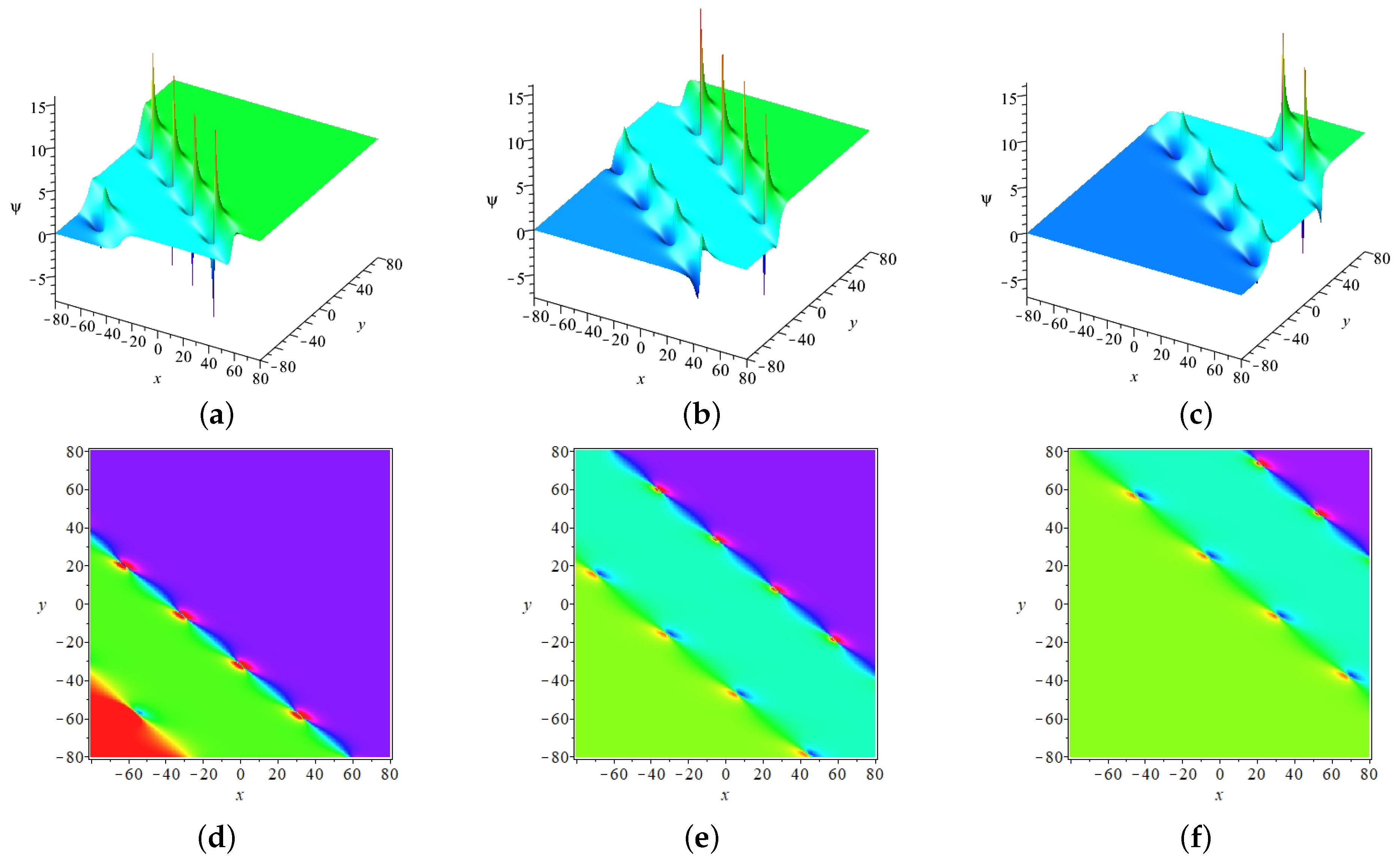
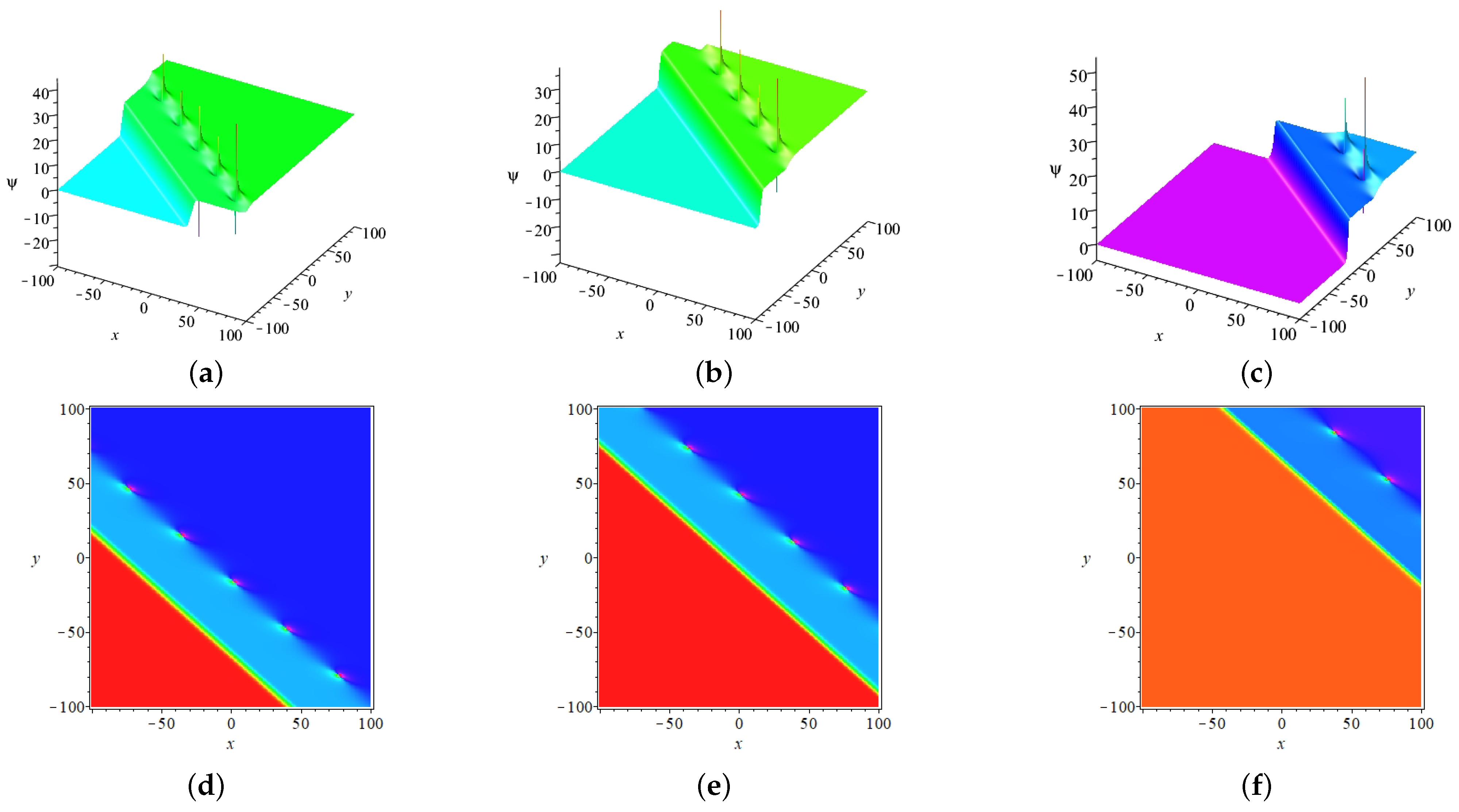
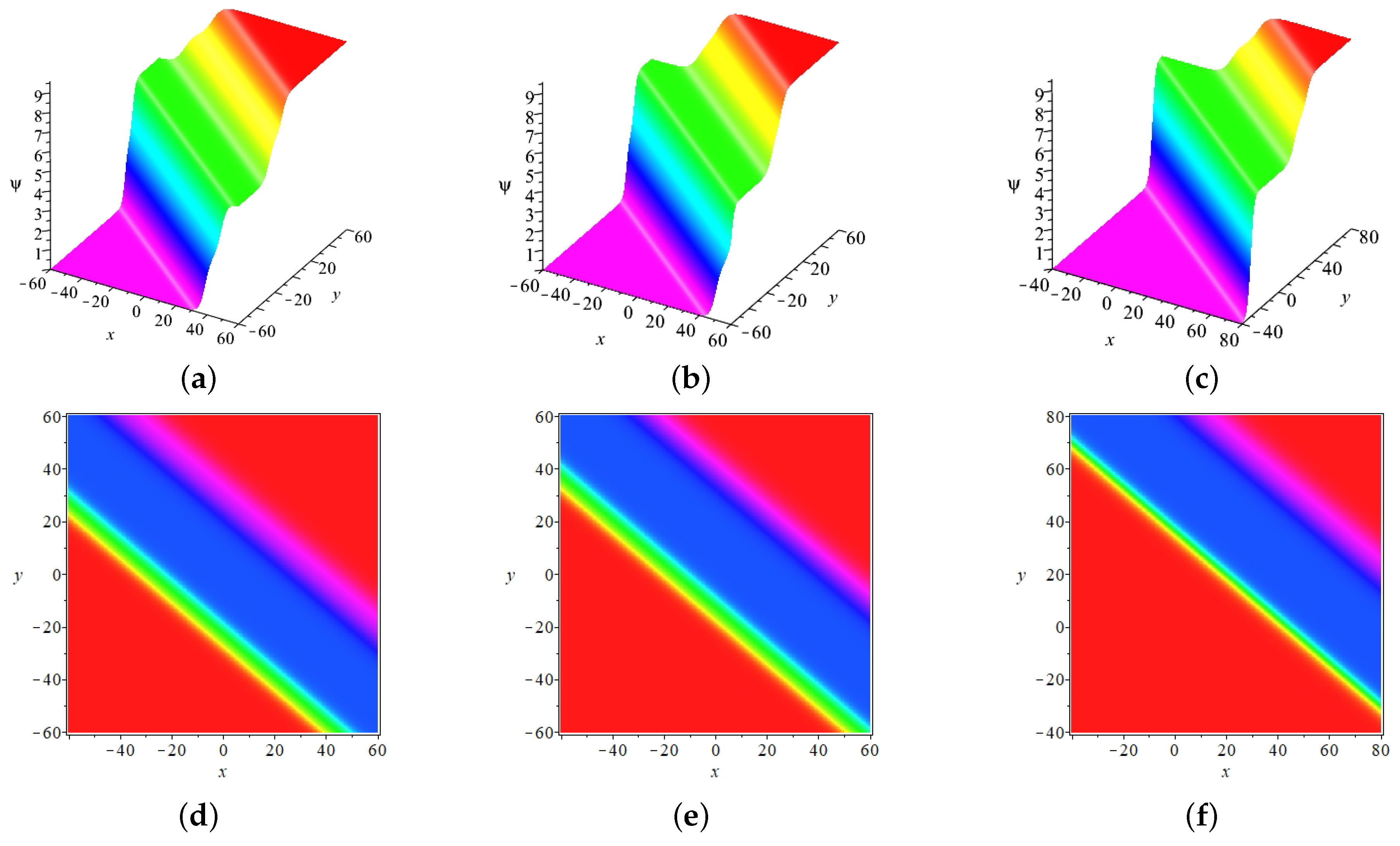
Disclaimer/Publisher’s Note: The statements, opinions and data contained in all publications are solely those of the individual author(s) and contributor(s) and not of MDPI and/or the editor(s). MDPI and/or the editor(s) disclaim responsibility for any injury to people or property resulting from any ideas, methods, instructions or products referred to in the content. |
© 2023 by the authors. Licensee MDPI, Basel, Switzerland. This article is an open access article distributed under the terms and conditions of the Creative Commons Attribution (CC BY) license (https://creativecommons.org/licenses/by/4.0/).
Share and Cite
Zhang, J.; Yue, J.; Zhao, Z.; Zhang, Y. Breathers, Transformation Mechanisms and Their Molecular State of a (3+1)-Dimensional Generalized Yu–Toda–Sasa–Fukuyama Equation. Mathematics 2023, 11, 1755. https://doi.org/10.3390/math11071755
Zhang J, Yue J, Zhao Z, Zhang Y. Breathers, Transformation Mechanisms and Their Molecular State of a (3+1)-Dimensional Generalized Yu–Toda–Sasa–Fukuyama Equation. Mathematics. 2023; 11(7):1755. https://doi.org/10.3390/math11071755
Chicago/Turabian StyleZhang, Jian, Juan Yue, Zhonglong Zhao, and Yufeng Zhang. 2023. "Breathers, Transformation Mechanisms and Their Molecular State of a (3+1)-Dimensional Generalized Yu–Toda–Sasa–Fukuyama Equation" Mathematics 11, no. 7: 1755. https://doi.org/10.3390/math11071755
APA StyleZhang, J., Yue, J., Zhao, Z., & Zhang, Y. (2023). Breathers, Transformation Mechanisms and Their Molecular State of a (3+1)-Dimensional Generalized Yu–Toda–Sasa–Fukuyama Equation. Mathematics, 11(7), 1755. https://doi.org/10.3390/math11071755






